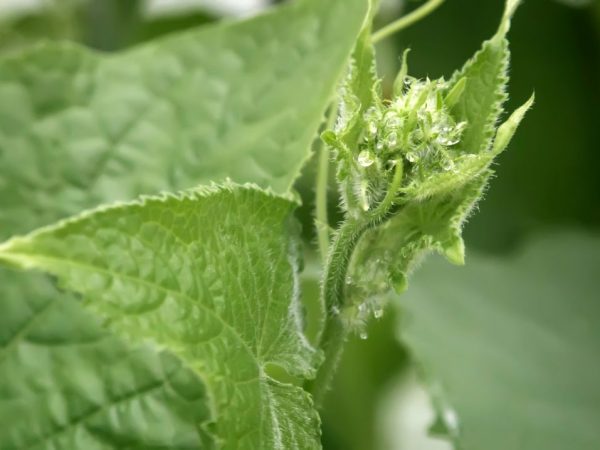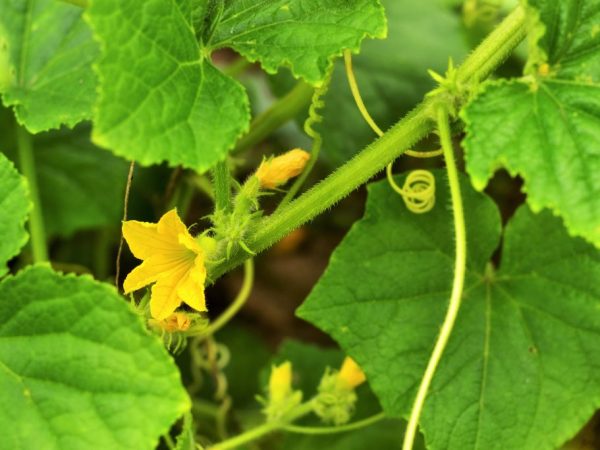Causes of pallor of leaves in cucumbers
Pale leaves in cucumbers - this phenomenon is not so often observed by gardeners. Leaf plates can change color for various reasons: lack of certain nutrients, improper care, or non-compliance with the temperature regime. It is necessary to carefully study these reasons in order to carry out timely prevention or treatment.

Causes of pallor of leaves in cucumbers
Why do the leaves turn pale
Gardeners are often found with pathological processes that are manifested by the pale color of the leaves in cucumbers. They depend on what element the plant lacks, or, conversely, what nutrients are supplied in excess.
Green leaves turn pale light green due to improper care or adverse weather conditions.
Improper care
Pathological processes do not necessarily indicate a lack of nutrients in the soil. Sometimes it happens that these substances are not absorbed due to improper care. Nitrogen deficiency can occur due to a lack of moisture. Too dry soil becomes the cause of attenuation of the activity of beneficial microorganisms, available nitrogen disappears, which leads to blanching of the leaves. Seedlings and cucumbers require regular watering.
Some gardeners, without fully figuring out the reasons, rush to feed. But an excess of nitrogen will lead to the accumulation of nitrates in the fruits, from which their quality will noticeably decrease. The cause can be eliminated by correct and regular watering - after a week the leaves will acquire a natural color.
If the situation is critical, the cucumbers are fertilized, but top dressing cannot be carried out before harvesting.
The appearance of leaves on the crop, resembling a dome with a light border around the edges, often misleads vegetable growers, since the same symptoms may indicate damage to the roots. The discovery of yellow, dry roots indicates a serious illness and feeding is indispensable. The root system can turn yellow from an overabundance of certain nutrients in the soil.
Weather
It happens that the root system is completely healthy, and the plant is completely supplied with potassium. But the leaves of cucumbers for some reason lose their former brightness.
This happens due to the long absence of good weather, when the process of photosynthesis is disrupted and trace elements flow out of the foliage. With the onset of sunny days, the organs acquire a natural color, and the problem is eliminated by itself.
Lack or excess of micronutrients
Experts identify several reasons why the leaves of cucumbers are discolored. Here are the main ones:
- Lack of nitrogen is easy to identify by slow growth, thin and hard branches that woody quickly. The foliage is smaller than usual, and the sharp ends point upward. Lateral shoots are almost not formed, the ovary falls off, most of the flowers dry up. At the initial stage of the disease state, the leaf plates turn yellow in old organs, then young organs are affected.Nitrogen starvation is manifested over time by the light color of medium leaves and the pale color of cucumbers. At first, thin veins remain green, but they also lose color over time, and even new organs immediately grow light green. pale-colored cucumbers are small in size and become pointed at the end.
- An excess of boron is manifested by the pale green color of the foliage in cucumbers. Then the green plates take on a lemon yellow color. With the aggravation of the painful condition, spots of light yellow color appear, surprisingly evenly spaced along the edges of the plates. The rest of the plate, especially the middle part, remains a normal saturated green. The stained tissue dies and collapses, and symptoms spread to all organs. Necrotic tissues curl, the disease progresses, which can cause necrosis of the entire plant.
- With a lack of iron, young leaves lose their color, only the main veins remain green. With the spread of the disease state, the entire plate is affected by chlorosis, all organs are involved in the pathological process. At an advanced stage, their edges die off, but the fruits do not suffer in any way.
- An excess of potassium is manifested by the pallor and yellowness of the oldest organs.
- Calcium deficiency is manifested by the formation of small leaves of a rich green color and short internodes. Young organs become pale green, covered with light stripes. Over time, they become wider, and their affected part dies off.
- Lack of phosphorus is very rare. If vegetable growers follow the recommendations and apply all fertilizers, then the plant will be provided with nutrients in full. But this chemical element is poorly absorbed in alkaline soil. The reaction of the soil must be checked with a litmus test. If the fears are confirmed, then the earth is acidified with peat or sawdust. Phosphorus deficiency is manifested by inhibition of crop growth, small foliage, dense and watery. After a while, they disappear.
- With a lack of copper, the tips of the plates turn pale and lighter, lose their elasticity and dry out.
- Lack of molybdenum - foliage loses its rich color.
- Potassium deficiency provokes yellowing of the plates, and over time they turn brown.
There are cases that an excess of some fertilizers leads to a shortage of others. This happens most often with nitrogen and potassium. Excess nitrogen is manifested by large organs, numerous flowers, but the ovary is formed later and the fruits ripen longer. An increased concentration of potassium in the soil causes rapid flowering and fruit formation, but crops inhibit growth, and as a result, the amount of harvest is sharply reduced. At a high concentration of calcium, cultures poorly assimilate manganese, zinc and copper.

Keep a close eye on the plants
The external symptoms of nutritional deficiencies can be varied, but common pathologies in growth and development are also present. An experienced gardener visually determines that something is wrong with the plant.
Solution to the problem
Lack of any nutrients negatively affects the vegetation of cucumbers, as well as their yield. An urgent need to fertilize with the necessary fertilizers. The concentration of the solution should be low, up to 0.3%.
In most cases, a deficiency of nutrients is observed on infertile soils, but it is also impossible to make highly concentrated fertilizing, as this will cause plant poisoning. Foliar dressing can be carried out with a 0.1% solution of the necessary fertilizer.
In case of prolonged cold and cloudy weather, a comprehensive foliar feeding is carried out: take 5 g of potassium chloride, ammonium nitrate and superphosphate per bucket of water. The solution should stand for 24 hours. Foliar dressing of cucumbers is recommended in June.Fertilizers are applied in the evening so that the seedlings do not suffer from the scorching sun.
Disease prevention
Prevention of pale leaves in cucumbers allows you to prevent the development of a painful condition. It includes the following activities:
- Top dressing of plants every 14 days. It is not recommended to apply fertilizer to dry soil or early in the morning. It is best to water the plants in the morning and fertilize in the evening. Do not exceed the dose of fertilizers indicated on the packaging by the manufacturer.
- Compliance with crop rotation.
- Timely and regular watering of crops.
- Mulching the soil as a protection against premature evaporation of moisture.
- Continuous control of air humidity in greenhouses.
For feeding, both mineral fertilizers and organic matter are used. Treatment of plants with a solution consisting of laundry soap (20 g), 30 drops of iodine and a liter of milk two weeks after germination helps to strengthen their immune system and even protect them from some pests.
It is necessary to differentiate the symptoms of insufficient or high nutrient content from diseases, infestation of crops by harmful insects, improper care or bad weather conditions.
Conclusion
According to external symptoms, experienced vegetable growers identify a deficiency of a particular chemical element and eliminate the painful condition with top dressing. But it is best not to wait for these alarms, but to apply fertilizers according to the instructions of specialists, depending on the composition of the soil. Then the painful condition can be avoided, and as a result, a good harvest can be obtained.


